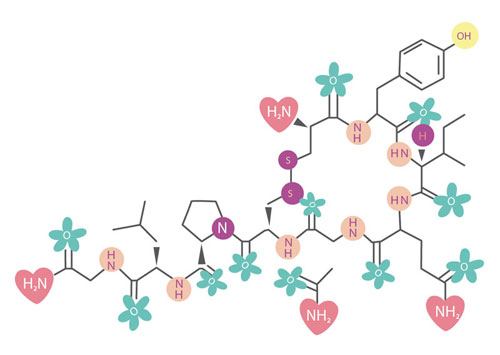Use of Oxytocin in Dairy Animals and Its Harmful Effects (3)
Read the second part of the article

Discussion at the end of the study
As mentioned earlier, the parable of the good Samaritan describes a highly influential ethical maxim of helping outgroup members who have fallen in need, and has attained paramount political significance in the African-American civil rights movement. However, as yet, the social and biological conditions promoting such outgroup-directed altruism have not been determined. In the study we show that enhanced activity of the OXT system paired with charitable social cues can help counter the effects of xenophobia by fostering altruism toward refugees. These results are especially important in the light of evidence that even a minority of selfish noncooperators may suffice to force the majority of altruists to defect, resulting in a rapid decay of altruistic cooperation within a population. Therefore, selfish motives impose an impending threat to altruistic cooperation.
In this study we demonstrate that normative incentives co-occurring with elevated activity of the OXT system exert a motivational force for inducing altruistic cooperation with outsiders, even in those individuals who refuse to do so in the absence of such exogenous triggers. Since their selfless behavior only emerged as a result of OXT-enhanced social norm compliance, it is extrinsically motivated. However, even intrinsically motivated (i.e., self-generated) forms of altruism may build on internalized social (e.g., parental) norms and engage endogenous OXT signaling.
Consistent with previous observations that OXTIN increases generosity per se, we found a generalized increase in donations toward both the outgroup and the ingroup. However, this effect was mainly driven by the higher donations of the Xi low scorers, and therefore is in line with evidence emphasizing a sensitivity of OXTIN effects to person- and context-dependent factors.
Whereas previous studies have focused either on the efficacy of ingroup norms as a potential means of stabilizing altruistic cooperation or on the facilitating effects of OXT signaling on social conformity, none have combined both interventions to enhance social norm adherence. Here, we provide evidence that a xenophobic rejection of refugees can be reversed by coupling enhanced activity of the OXT system to a normative incentive for cooperation with peers; neither intervention alone was sufficient to alter selfish responses in Xi high scorers, illustrating the relative resistance of outgroup rejection to exogenous modification.
Unfortunately, open and latent xenophobia continue to be a major challenge for European democracies. Since foraging societies were afflicted by intergroup conflict at all times, a strong inclination to categorically differentiate between ingroup (“us”) and outgroup (“them”) members may have conferred evolutionary advantages. Warfare may even have catalyzed cultural selection, as the dominant groups have forced their social preferences and norms on the defeated groups. Our results raise the question of whether higher levels of xenophobia could be associated with a reduced sensitivity to others’ distress, irrespective of their group membership. This may explain why the Xi high scorers in our sample did not exhibit an altruism bias to either group. It should be emphasized, though, that the measured Xi scores represent relatively typical levels of xenophobia within the general population. Based on the heterogeneity of xenophobic attitudes within certain groups and regions, future research with a focus on the extreme ends of xenophobia is needed to provide a more nuanced understanding of the effects of OXTIN on outgroup-directed altruism.
Furthermore, given that OXTIN can produce sexual-dimorphic effects, we cannot extrapolate our findings to women. Clearly, future studies are warranted to explore the relationship between the effects of OXTIN on outgroup-directed altruism and a wider array of person- and context-dependent factors, including sex, age, and self-report measures of xenophobia.

In contrast to previous studies, which have used OXTIN to illustrate a contribution of OXT signaling in parochial altruism, especially under circumstances of intergroup conflict, we demonstrate that enhanced activity of the OXT system facilitates social norm compliance, thus inducing altruism toward outgroup members even in the most selfish and xenophobic individuals. Given evidence indicating that social group activities with peers, such as singing in a choir, are associated with elevated endogenous OXT release, our findings suggest that greater focus should be placed on enabling positive social encounters among citizens of hosting countries that communicate a prosocial norm; that is, by affirming and emphasizing the benefits of ethnic diversity, religious pluralism, and cultural differentiation.
This may include the promotion of balanced and informed media reporting, the integration of refugee themes to the curricula of schools and universities, or the organization of events that involve the general public and bring communities together by promoting sustained experience- and information-sharing on the situation of refugees. The effect of solutions combining selective enhancement of OXT signaling and peer influence would be expected to diminish selfish motives, and thereby increase the ease by which people adapt to rapidly changing social ecosystems. More generally, our results imply that an OXT-enforced social norm adherence could be instrumental in motivating a more generalized acceptance toward ethnic diversity, religious plurality, and cultural differentiation resulting from migration by proposing that interventions to increase altruism are most effective when charitable social cues instill the notion that one’s ingroup shows strong affection for an outgroup.
Furthermore, UNESCO has emphasized the importance of developing neurobiologically informed strategies for reducing xenophobic, hostile, and discriminatory attitudes. Thus, considering OXT-enforced normative incentives in developing future interventions and policy programs intended to reduce outgroup rejection may be an important step toward making the principle of social inclusion a daily reality in our societies.
Materials and Methods
Our study was approved by the Institutional Review Board of the Faculty of Medicine of the University of Bonn, and was carried out in compliance with the latest revision of the Declaration of Helsinki. All participants gave written, informed consent.
Experimental Design
The altruistic donation task, which was framed in the context of Europe’s refugee crisis, included 50 authentic case vignettes in total. Each of the 25 ingroup case vignettes had a corresponding outgroup counterpart (Fig. S1 – in the second part of the article). The descriptions presented in the vignettes were composed in a standardized manner to keep them identical regarding formal criteria such as style, word count, and format. Each individual was introduced by his/her name, age, place of birth, country of origin, and personal need. The selection of home countries for the outgroup frame was based on reports published in 2015 by the European Commission, documenting conflicts, persecution, and poverty in the Middle East and Eastern Europe as the major drivers of forced migration to the European Union. Personal needs comprised those essential elements the United Nations has defined as minimum standards for leading a safe and dignified life; that is, access to food, adequate housing, or participation in social and cultural life. All 50 case scenarios were balanced in terms of age and sex of the needy persons and were presented in random order. The participants read and completed the donation task at their own pace. Subjects were endowed with 50 Euros and could donate a maximum of 1 Euro to each case, leaving them the rest (0–50 Euros) as personal payoff, if the lottery ticket, which they drew on completion of the donation task, had a number on the inside (chance of winning: 10%). Furthermore, subjects were informed that all their donations were subtracted from this endowment of 50 Euros.
Procedure and Participants
Experiment 1.
In Experiment 1, a total of 76 healthy female (n = 53) and male (n = 23) undergraduate students (mean age 21.2 ± 3.0 years old) completed the donation task. The rationale of Experiment 1 was to generate normative cues for altruistic responding toward refugees. For this purpose, subjects were assembled in a lecture hall. Using a paper–pencil version of the altruistic donation task, the participants were instructed to indicate the exact amount of their donation for each case vignette on the forms, which were later collected by the experimenter. By design, this experimental setting enabled reputation pressures due to social interactions among peers, such that the sums donated in Experiment 1 were higher than those from Experiments 2 and 3, in which we eliminated social interaction.

Experiments 2 and 3
For Experiments 2 and 3, a new group of participants was invited to sign up for the experiment via the online database hroot of the BonnEconLab. A total of 127 healthy male volunteers enrolled in the double-blind, randomized, parallel-group trial design and self-administered a dose of 24 IU (three puffs per nostril, each with 4 IU; Novartis) of OXTINor PLCIN 40–45 min before the start of the donation task. The placebo solution contained the identical ingredients except the peptide itself. The study comprised a screening session in the morning and an experimental session in the afternoon. Screening entailed the exclusion of current or past physical or psychiatric illness (including drug and alcohol abuse), as assessed by medical history and the Mini-International Neuropsychiatric Interview. To control for possible pretreatment differences, we assessed anxiety traits with the State-Trait Anxiety Inventory, depressive symptoms with the Beck Depression Inventory, early social adversity with the Childhood-Trauma-Questionnaire, and autistic-like traits with the Autism-Spectrum-Quotient. Furthermore, we assessed cooperative and altruistic attitudes based on the subjects’ social value orientation, as well as empathy with the Interpersonal Reactivity Index and their susceptibility to external (dis)approval with the Social Desirability Scale. In addition, the subjects were asked to indicate their personal income and donation behavior during the last year. There were no a priori differences between the OXTIN and PLCIN groups for Xi low and high scorers. Moreover, subjects were naive to prescription-strength psychoactive medication and had not taken any over-the-counter psychoactive medication in the preceding 4 wk. Participants were asked to maintain their regular sleep and waking times and to abstain from caffeine and alcohol intake on the day of the test session. During testing, a total of 20 participants (OXTIN: n = 10; PLCIN: n = 10) could not complete the donation task due to technical issues. Thus, the final analyses were performed on data from 107 participants (mean age 24.16 ± 3.2 years old).
During Experiments 2 and 3, each participant was seated alone in front of a computer screen in a separate test cubicle that was closed off with curtains, while being exposed to the same donation task and instructional primes as established in Experiment 1. This experimental setting eliminated any interactions with peers or the experimenter. To exclude potential confounding influences of sex differences, we compared OXT effects between male participants, rather than between men and women. Participants performed two runs of the donation task. In Experiment 2, participants had no further information than that they could donate some, none, or all of their money with a maximum of 1 Euro for each case vignette (Fig. S1 – in the second part of the article). In Experiment 3, the same sample of participants was additionally informed about the higher average donations made by their peers in each scenario (e.g., “Your peers previously donated 0.50 Euro”) (Fig. S2 – in the previous part of the article). The scenarios of the donation task were presented with the software Qualtrics. Participants were asked to indicate their donation by moving a slider placed under each scenario. By varying the starting positions of the slider, each choice required a similar effort.
Xenophobia index
In a separate screening session, we evaluated xenophobia by measuring the attitudes toward refugees based on an adapted assessment instrument developed by Schweitzer and colleagues. Adaptions encompassed the wording; for example, “Australian refugee” was replaced by “German refugee”. The assessment instrument contained two inventories, in which participants indicated how strongly they associate refugees with realistic and symbolic threats. In our analyses, we focused on the realistic threat inventory, which includes seven items and has good internal consistency (Cronbach’s α = 0.83). This decision was based on previous evidence indicating that realistic threats (e.g., perceived threats to economic interest, social status, or health), rather than symbolic threats (e.g., perceived threats to morals, values, or beliefs), more robustly predict perceptions of xenophobia. The realistic threat scale items encompass different threat perceptions; for example: “Refugees are not displacing German workers from their jobs” or “Refugees have increased the tax burden on Germans”. Responses were coded on a 10-point Likert scale, ranging from 1 (“I strongly disagree”) to 10 (“I strongly agree”). All items were recoded such that higher values reflected greater feelings of perceived realistic threats. The term Xi index, which we used for subsequent analyses, refers to a subject’s mean score achieved on the realistic threat inventory.

Statistical Analysis
Demographic, neuropsychological, and behavioral data were analyzed using IBM SPSS Statistics 24. Quantitative behavioral data were compared using mixed analysis of variance and post hoc t-tests. Pearson’s product-moment correlation was used for correlation analysis. Eta-squared and Cohen’s d were calculated as measures of effect size. For qualitative variables, Pearson’s χ2 tests were used. All reported P values are two-tailed if not otherwise stated, and P values of P < 0.05 were considered significant.
All relevant data are stored on a server of the Division of Medical Psychology at the University of Bonn Medical Center and are available for research purposes on request by contacting R.H.
yogaesoteric
July 24, 2018
Also available in:
 Română
Română
